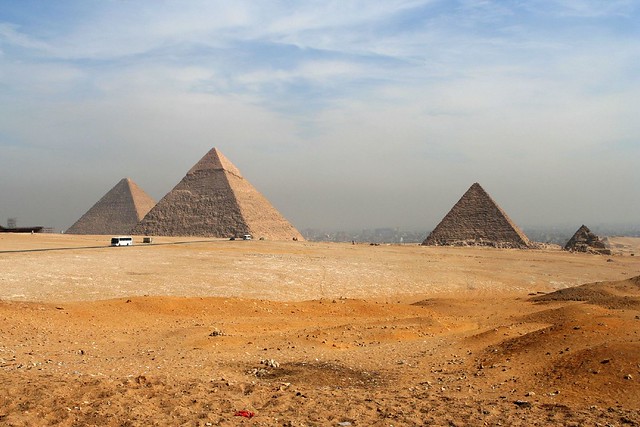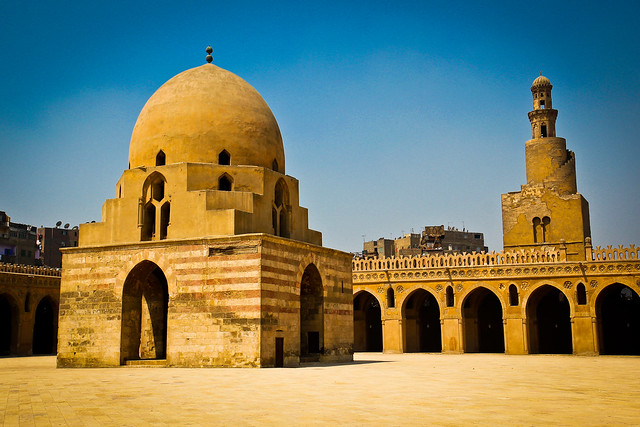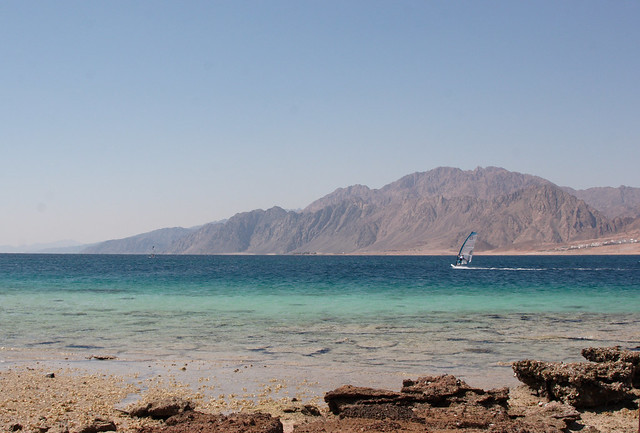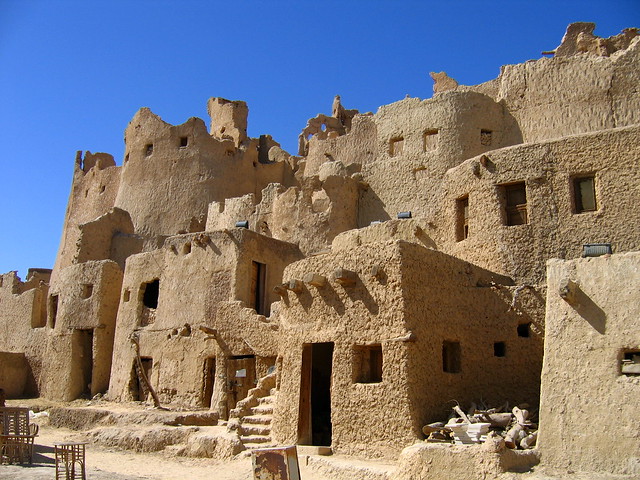Egypt is famous for its ancient civilization and some of the world’s most famous monuments, including the Giza pyramids, the Great Sphinx and the ancient temples of Luxor dating back thousands of years. Although focus of most tourist visits remains the great monuments along the Nile, possibilities for Egyptian travel also includes snorkeling and diving along the Red Sea coast. Other tourist attractions in Egypt include camel trips into the mountains of Sinai, tours to remote oases or visits to the Coptic monasteries of the Eastern Desert.
Giza Necropolis
 flickr/Tommy Wong
flickr/Tommy Wong
The Pyramids of Giza, situated in the immediate vicinity of the southwestern suburbs of Cairo are the undisputable top attractions in Egypt. The pyramids at Giza were built over the span of three generations – by Khufu, his second reigning son Khafre, and Menkaure. The Great Pyramid of Khufu is an awe-inspiring 139 meters (455 feet) high making it the largest pyramid in Egypt, although nearby Khafre’s Pyramid appears to be larger as it is build at a higher elevation.
Karnak
 flickr/Mr. Theklan
flickr/Mr. Theklan
Although badly ruined, few sites in Egypt are more impressive than Karnak. It is the largest ancient religious site ever built, and represents the combined achievement of many generations of Egyptian builders. The Temple of Karnak actually consists of three main temples, smaller enclosed temples, and several outer temples located about 2.5 kilometers north of Luxor. One of most famous structures of Karnak is the Hypostyle Hall, a hall area of 5,000 m2 (50,000 sq ft) with 134 massive columns arranged in 16 rows.
Red Sea Reef
 flickr/Nataraj Metz
flickr/Nataraj Metz
The Red Sea, off the coast of Egypt, is one of the most beautiful places in the world to go diving. The waters of the Red Sea are renowned for their spectacular visibility and features some of the most exotic seascapes. With its wide expanse of coral formation on the reefs, it is home to thousands of different sea creatures. Red Sea beach resorts are located on both sides of the sea, on the east side and part of the Sinai peninsula is the long established Sharm el Sheikh and its neo-hippy counterpart, Dahab. On the west coast of the Red Sea lies relatively old and touristy Hurghada and a cluster of new resort towns.
River Nile Cruise
 Photo by D’Arcy Vallance
Photo by D’Arcy Vallance
Cruising the Nile is a popular way of visiting upper Egypt. The Nile River has been Egypt’s lifeline since ancient times and there is no better way to trace the passage of Egypt’s history than to follow the course of the Nile. Almost all Egyptian cruise ships travel the Luxor-Aswan route which is safe, scenic and terminates at two of Egypt’s most important towns. Taking a Felucca down the Nile is an adventurous option. Feluccas are sail boats that have been used on the Nile since antiquity. A Felucca is not quite as comfortable as a luxury cruise ship but nothing can beat sailing in a quiet rig that was designed thousands of years ago.
Valley of the Kings
 flickr/Jean-Pierre Dalbera
flickr/Jean-Pierre Dalbera
The Valley of the Kings near Luxor is a valley where, for a period of nearly 500 years from the 16th to 11th century BC, tombs were constructed for the kings and privileged nobles of the New Kingdom. The valley contains 63 tombs and chambers, ranging in size from a simple pit to a complex tomb with over 120 chambers. The royal tombs are decorated with scenes from Egyptian mythology and give clues to the beliefs and funerary rituals of the period. All of the tombs seem have been opened and robbed in antiquity except for the famous tomb of Tutankhamun.
Mosque of Ibn Tulun
 flickr/modenadude
flickr/modenadude
Built between 876 and 879 AD, the Mosque of Ibn Tulun is one of the oldest mosques in Cairo. It was commissioned by Ahmad ibn Ţūlūn, the Abbassid governor of Egypt. The mosque is constructed around a courtyard, with one covered hall on each of the four sides. The minaret, which features a helical outer staircase similar to that of the famous minaret in Samarra, was probably built several centuries later. Parts of the James Bond film The Spy Who Loved Me were filmed at the Mosque of Ibn Tulun.
Dahab
 flickr/Shearwater
flickr/Shearwater
Dahab is located some 85 km (53 miles) north of Sharm el-Sheikh on the Gulf of Aqaba, near the southern tip of Sinai. Once an isolated coastal village, Dahab turned into a hippie hangout in the 1980’s and became something of an “alternative resort”, mixing cheap accommodation with a laid back lifestyle. Activities such as wind surfing, snorkeling, scuba diving and camel and jeep trips make it one of the most popular destinations along the Red Sea.
Siwa Oasis
 flickr/tronics
flickr/tronics
Located in the Libyan Desert, Siwa Oasis is one of Egypt’s isolated settlements, with 23,000 people, mostly ethnic Berbers. Located on an old date trade route, Siwa was an oasis vital to the trade route, as the natural springs and shade giving palm trees gave travelers respite from the desert. With the collapse of the Roman Empire, Siwa began its decline. In recent decades tourism has become a vital source of income. Much attention has been given to creating hotels that use local materials and play on local styles.
Egyptian Museum
 flickr/tutincommon
flickr/tutincommon
Home to at least 120,000 items of ancient Egyptian antiquities, the Egyptian Museum is one of Cairo’s top attraction. There are two main floors of the museum, the ground floor and the first floor. On the ground floor there is an extensive collection of papyrus and coins used in by the ancient Egyptians. On the first floor there are artifacts from the final two dynasties of Ancient Egypt and also many artifacts taken from the Valley of the Kings. Highlights include the objects from the Tomb of Tutankhamen and the Royal Mummy Room containing 27 royal mummies from pharaonic times.
Abu Simbel
 flickr/Mrs Logic
flickr/Mrs Logic
Abu Simbel is an archaeological site comprising two massive rock-cut temples in southern Egypt on the western bank of Lake Nasser. The twin temples were originally carved out of the mountainside during the reign of Pharaoh Ramesses The Great in the 13th century BC, as a lasting monument to himself and his queen Nefertari. The complex was relocated in its entirety in the 1960s, when the temples were threatened by submersion in Lake Nasser, due to the construction of the Aswan High Dam. Abu Simbel remains one of Egypt’s top tourist attractions.




































